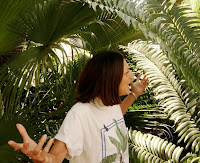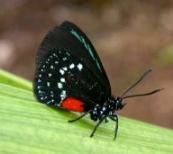June 2008 Atalas, Zebras, Dragons and PANDAS!
Coonties everywhere are a-bloom with the bright red and yellow atala larvae, causing consternation or joy depending on the owner of said plants. Home owners exalt when they see Atala the Hun at work, but landscapers and city planners often struggle with wanting to help keep a species stable….and wanting to protect their ornamental edging from being destroyed by the larvae.
An enlightened city planner would make interpretive signs explaining the unique history of this once-thought extinct insect and its beautiful but poisonous host plant. At the very least, a city planner could call on the atala “rescue teams” and have one of us move the offenders to a safe location, thereby establishing another atala colony.
Dick Freshley at Okeeheelee Nature Center asked if there is a way to differentiate male and female atalas other than the upper surface of the wings. Males have a splash of iridescent greenish-teal-blue on the upper surface and females have a streak of bright royal blue on the upper wing surface. It can be difficult to see the colors when they are fluttering by.
 This is the upper forewing surface of a male--notice that there is more diffuse softer greenish-bluish color over a larger area.
This is the upper forewing surface of a male--notice that there is more diffuse softer greenish-bluish color over a larger area.
 This is a female’s upper forewing surface—you can see that the color is concentrated and is a streak of bright royal blue (not a diffuse wash of color).
This is a female’s upper forewing surface—you can see that the color is concentrated and is a streak of bright royal blue (not a diffuse wash of color).
 Female atalas, on the other hand, have a smaller lighter spot on the tip of the abdomen, which leads to the ovipositor (which she uses to lay her eggs). So now you have two ways to identify the males and females.
Female atalas, on the other hand, have a smaller lighter spot on the tip of the abdomen, which leads to the ovipositor (which she uses to lay her eggs). So now you have two ways to identify the males and females.
In the process of capturing these atalas for the impromptu photo shoot, I was surprised to miss several in a row---They are notoriously easy to catch!
capturing these atalas for the impromptu photo shoot, I was surprised to miss several in a row---They are notoriously easy to catch!
 Zebra Heliconius was also fluttering everywhere in the Medicinal Garden, next to the atala's garden.
Zebra Heliconius was also fluttering everywhere in the Medicinal Garden, next to the atala's garden.

2.JPG) A beautiful Golden-winged Skimmer (Libellula auripennis) was using one of the decimated milkweed stems as a look-out perch the other day. What a vibrant dragonfly! And another Golden-winged was ‘captured’ at John U Lloyd
A beautiful Golden-winged Skimmer (Libellula auripennis) was using one of the decimated milkweed stems as a look-out perch the other day. What a vibrant dragonfly! And another Golden-winged was ‘captured’ at John U Lloyd  Beach State Park, too.
Beach State Park, too.
It looks like summer programs at John Williams Park will remain as exotic plant workshops and not the fun activities I had hoped for…liability insurance is not affordable for the small numbers of children expected to attend. Maybe next year!
 In the meantime, I am helping Dr. Barry Barker and the Wildspots Foundation with fund-raising for the earthquake-stricken Wolong Panda Institute news, located near Chengdu in China.
In the meantime, I am helping Dr. Barry Barker and the Wildspots Foundation with fund-raising for the earthquake-stricken Wolong Panda Institute news, located near Chengdu in China.
We have been told that although the pandas are safe, the access to them is impossible because the road to Wolong has been completely destroyed and damage throughout the area is severe. Wolong will be closed until next Spring because of the accessibility issues. Chengdu Panda operation in Chengdu needs help. Wildspots is sending volunteers there Sept 19-28. If you would like to volunteer for the trip to help, or buy a beautiful photographic book (this photo is by Tom Isgar, one of the photographers in the book) being published by Wildspots to raise money for the panda preserve, go to the Wildspots website or email Dr. Barker directly: barkerb@wildspotsfoundation.org.
And please remember that your help removing exotics is appreciated at John Williams Park, 6101 Sheridan Street this coming Saturday, May 24, 2008 from 9 AM-noon!
An enlightened city planner would make interpretive signs explaining the unique history of this once-thought extinct insect and its beautiful but poisonous host plant. At the very least, a city planner could call on the atala “rescue teams” and have one of us move the offenders to a safe location, thereby establishing another atala colony.
Dick Freshley at Okeeheelee Nature Center asked if there is a way to differentiate male and female atalas other than the upper surface of the wings. Males have a splash of iridescent greenish-teal-blue on the upper surface and females have a streak of bright royal blue on the upper wing surface. It can be difficult to see the colors when they are fluttering by.
 This is the upper forewing surface of a male--notice that there is more diffuse softer greenish-bluish color over a larger area.
This is the upper forewing surface of a male--notice that there is more diffuse softer greenish-bluish color over a larger area. This is a female’s upper forewing surface—you can see that the color is concentrated and is a streak of bright royal blue (not a diffuse wash of color).
This is a female’s upper forewing surface—you can see that the color is concentrated and is a streak of bright royal blue (not a diffuse wash of color).But yes, there IS another way to sex the atalas!

Males have a very dark spot on the very tip of the abdomen which leads to scent glands located within. When the male is courting a female, he will evert these brush-like glands to release pheromones that he hopes will attract the female.

Males have a very dark spot on the very tip of the abdomen which leads to scent glands located within. When the male is courting a female, he will evert these brush-like glands to release pheromones that he hopes will attract the female.
 Female atalas, on the other hand, have a smaller lighter spot on the tip of the abdomen, which leads to the ovipositor (which she uses to lay her eggs). So now you have two ways to identify the males and females.
Female atalas, on the other hand, have a smaller lighter spot on the tip of the abdomen, which leads to the ovipositor (which she uses to lay her eggs). So now you have two ways to identify the males and females.In the process of
 capturing these atalas for the impromptu photo shoot, I was surprised to miss several in a row---They are notoriously easy to catch!
capturing these atalas for the impromptu photo shoot, I was surprised to miss several in a row---They are notoriously easy to catch! “How did I miss another one?” I asked Dr Joshua Feingold, who was kind enough to take these photos for me in the NSU Mesozoic Garden.
 Zebra Heliconius was also fluttering everywhere in the Medicinal Garden, next to the atala's garden.
Zebra Heliconius was also fluttering everywhere in the Medicinal Garden, next to the atala's garden. The Corky Stem Passionfruit was flowering, and females were laying the delicate gold eggs on  the tips of the new growth. Larger larvae were happily munching.
the tips of the new growth. Larger larvae were happily munching.
 the tips of the new growth. Larger larvae were happily munching.
the tips of the new growth. Larger larvae were happily munching.
2.JPG) A beautiful Golden-winged Skimmer (Libellula auripennis) was using one of the decimated milkweed stems as a look-out perch the other day. What a vibrant dragonfly! And another Golden-winged was ‘captured’ at John U Lloyd
A beautiful Golden-winged Skimmer (Libellula auripennis) was using one of the decimated milkweed stems as a look-out perch the other day. What a vibrant dragonfly! And another Golden-winged was ‘captured’ at John U Lloyd  Beach State Park, too.
Beach State Park, too.It looks like summer programs at John Williams Park will remain as exotic plant workshops and not the fun activities I had hoped for…liability insurance is not affordable for the small numbers of children expected to attend. Maybe next year!
 In the meantime, I am helping Dr. Barry Barker and the Wildspots Foundation with fund-raising for the earthquake-stricken Wolong Panda Institute news, located near Chengdu in China.
In the meantime, I am helping Dr. Barry Barker and the Wildspots Foundation with fund-raising for the earthquake-stricken Wolong Panda Institute news, located near Chengdu in China.We have been told that although the pandas are safe, the access to them is impossible because the road to Wolong has been completely destroyed and damage throughout the area is severe. Wolong will be closed until next Spring because of the accessibility issues. Chengdu Panda operation in Chengdu needs help. Wildspots is sending volunteers there Sept 19-28. If you would like to volunteer for the trip to help, or buy a beautiful photographic book (this photo is by Tom Isgar, one of the photographers in the book) being published by Wildspots to raise money for the panda preserve, go to the Wildspots website or email Dr. Barker directly: barkerb@wildspotsfoundation.org.
And please remember that your help removing exotics is appreciated at John Williams Park, 6101 Sheridan Street this coming Saturday, May 24, 2008 from 9 AM-noon!
Labels: atalas dragons zebras and pandas




0 Comments:
Post a Comment
<< Home